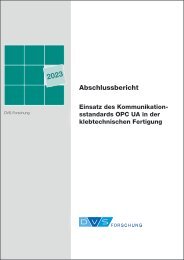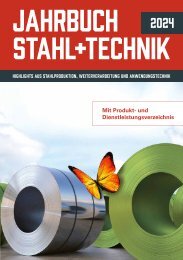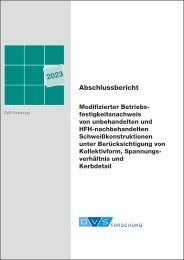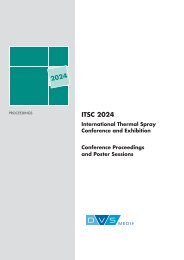STEEL + TECHNOLOGY 01/2020 EXTRACT
STEEL + TECHNOLOGY 01/2020 EXTRACT
STEEL + TECHNOLOGY 01/2020 EXTRACT
Create successful ePaper yourself
Turn your PDF publications into a flip-book with our unique Google optimized e-Paper software.
30 | COMPANIES<br />
Steelmaking<br />
SSAB to be first to market with fossil-free<br />
steel already in 2026<br />
The plan for transitioning to iron-ore based fossil-free steel production was presented to more than 400<br />
customers and key players in the industry, in conjunction with SSAB’s Swedish Steel Prize seminars in<br />
November 2<strong>01</strong>9 in Stockholm, Sweden<br />
Recently it was announced that the<br />
HYBRIT initiative, where SSAB is one<br />
of the owners, will step up work and<br />
that global steel company SSAB will be able<br />
to deliver fossil-free steel to the market<br />
already in 2026. In line with SSAB’s global<br />
ambitions, the company anticipates that its<br />
US operations, which utilize scrap-based<br />
electric arc furnace (EAF) technology, will be<br />
powered completely by renewable energy<br />
by 2022 in its Iowa operations. It will also be<br />
able to offer fossil-free steel products starting<br />
in 2026, utilizing sponge iron developed<br />
through the HYBRIT initiative in Sweden.<br />
That SSAB already at this stage seeks<br />
to engage customers in its plans to switch<br />
over to a completely new steelmaking<br />
technology is a natural step in the company’s<br />
ambition to step up the pace in transitioning<br />
to being fossil free.<br />
“It will take time for a completely new<br />
market for fossil-free products to emerge<br />
and so we need to start now. Together<br />
with our customers, we will work to find<br />
successful business models to launch fossil-free<br />
products on the market already in<br />
2026,” said Martin Lindqvist. “Fossil-free<br />
steel will also help other sectors such as<br />
automotive, heavy transport and construction<br />
to become fossil free. Together, we<br />
will be able to offer end-users a completely<br />
fossil free value chain, from the mine to<br />
the end product.”<br />
In 2<strong>01</strong>6, SSAB, together with LKAB and<br />
Vattenfall, launched the HYBRIT initiative<br />
with the goal to replace coal and coke,<br />
which are used as reduction agents in the<br />
steelmaking process, with fossil-free<br />
hydrogen gas. Interest in fossil-free steel<br />
has since grown rapidly.<br />
In September 2<strong>01</strong>9, Martin Lindqvist,<br />
representing the only steel company at the<br />
summit, was invited to the UN Climate<br />
Action Summit in New York, to talk about<br />
something which has hitherto been considered<br />
impossible, the potential for<br />
net-zero emissions in the steel industry.<br />
“We want to show that transition in the<br />
steel industry is not only possible, but truly<br />
necessary. When we show the way, I<br />
think others will follow,” said Martin Lindqvist.<br />
The steel industry accounts for around<br />
7% of global carbon dioxide emissions. In<br />
Sweden steelmaking accounts for 10%<br />
and in Finland for 7%. The technology to<br />
use hydrogen gas instead of coking coal to<br />
reduce iron ore is known, but has never<br />
been successfuly tested on an industrial<br />
scale. HYBRIT is now building a pilot plant<br />
Martin Lindqvist, SSAB’s President and CEO, presented the plan to more than 400 customers and key players in the industry in<br />
November in Stockholm. (Picture: SSAB)<br />
<strong>STEEL</strong> + <strong>TECHNOLOGY</strong> 2 (<strong>2020</strong>) No. 1


















